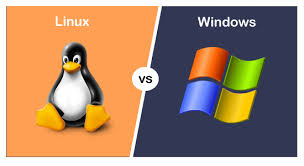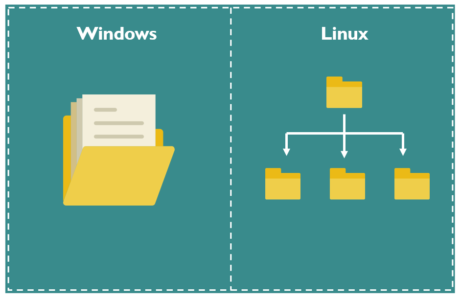Difference between Windows and Linux
 Rohit Ramteke
Rohit Ramteke
Preface
In the ever-evolving world of computing, two dominant operating systems, Windows and Linux, have carved out distinct spaces for themselves. Each system possesses unique features, licensing models, and user experiences that set them apart. In this overview, we explore the fundamental differences between Windows and Linux, shedding light on their kernel design, licensing, graphical user interfaces, software compatibility, file systems, command-line interfaces, hardware support, and community backing. Whether you're an avid user or an inquisitive newcomer, understanding the contrasts between these operating systems can help you make informed decisions about which one best suits your needs and preferences. Let's delve into the world of Windows and Linux to unravel their divergent paths and rich functionalities.
Difference Between Windows and Linux
Windows and Linux are two different operating systems that have distinct characteristics and are commonly used in the computing world. Here are some of the key differences between the two:

Kernel and Core Design:
Windows: Developed by Microsoft, Windows uses a closed-source kernel. It follows a centralized design approach and is not open to public modification.
Linux: Linux, on the other hand, uses an open-source kernel developed collaboratively by numerous contributors worldwide. It follows a decentralized design approach, allowing anyone to modify and distribute their customized versions (known as distributions or distros).
Licensing:
Windows: Windows operating system requires a license for usage, and Microsoft typically charges a fee for obtaining a valid license.
Linux: Linux, being open-source, is generally free to use. You can download, install, and distribute Linux distributions without any licensing costs.
Graphical User Interface (GUI):
Windows: Windows is known for its user-friendly GUI, which has been a significant part of its success and popularity.
Linux: Linux also has GUI environments, but the specific interface can vary significantly between different distributions. Some, like Ubuntu, are designed to be user-friendly, while others may require more technical expertise.
Software Compatibility:
Windows: Windows has a vast range of software and applications available due to its widespread adoption and developer support.
Linux: While Linux has grown in terms of software availability, it historically had fewer applications tailored for it. However, many popular software now have Linux versions or can run on Linux through compatibility layers.
File System:
Windows: Windows predominantly uses the NTFS file system (or FAT32 for older versions) for its primary partitions.
Linux: Linux can use various file systems, with Ext4 being the most commonly used for traditional hard drives and SSDs.
Command Line Interface (CLI):
Windows: Windows has a command prompt (cmd.exe) and, in later versions, PowerShell, which allows users to interact with the system through the command line.
Linux: Linux has the Terminal, which provides a command-line interface (CLI). The Terminal offers great power and flexibility for advanced users and system administrators.
Hardware Support:
Windows: Due to its popularity, Windows generally enjoys better compatibility with a wide range of hardware devices.
Linux: While Linux's hardware support has improved significantly over the years, some less common or proprietary hardware may still have limited driver support.
Community and Support:
Windows: As a commercial product, Windows comes with professional technical support from Microsoft.
Linux: Linux has a large and active community of users and developers who provide support through forums, documentation, and various online resources.
Both Windows and Linux have their strengths and weaknesses, and the choice between them often depends on specific requirements, user preferences, and the intended use of the operating system. Windows is more prevalent in desktop environments, while Linux dominates the server and embedded systems landscape.
The architecture of Windows and Linux
The kernel architecture of Linux and Windows refers to the internal design and organization of the core components responsible for managing system resources and providing essential services to applications and hardware. Here are some key differences between the kernel architectures of Linux and Windows:
Kernel Type:
Linux: Linux uses a monolithic kernel architecture. In this design, all essential kernel functionalities, such as process management, memory management, file system handling, and device drivers, are part of a single large kernel module. This results in efficient direct communication between components but can also lead to larger kernel size.
Windows: Windows employs a hybrid kernel architecture, combining aspects of both monolithic and microkernel designs. The core components, including process and memory management, are in kernel mode (ring 0) for performance reasons. However, some non-essential services, like drivers and some subsystems, run in user mode (ring 3) for better stability and isolation. This design aims to achieve a balance between performance and reliability.
Driver Model:
Linux: Linux follows a more uniform approach to device drivers. Most device drivers are treated as kernel modules, allowing them to be loaded and unloaded dynamically as needed. This modularity contributes to the flexibility and maintainability of the kernel.
Windows: In Windows, device drivers come in various forms, including monolithic drivers that are part of the kernel and user-mode drivers that run in user space. While this allows Windows to support a wide range of hardware, it can make driver management more complex.
Licensing:
Linux: The Linux kernel is released under open-source licenses (e.g., GNU General Public License - GPL). It is freely available to view, modify, and distribute, encouraging collaboration and community contributions.
Windows: Windows is a proprietary operating system, and its kernel source code is not publicly available. Microsoft maintains exclusive control over its development and distribution.
System Calls:
Linux: Linux provides a system call interface that allows user-space applications to request services from the kernel. This interface is consistent and well-documented, making it relatively straightforward for developers to interact with the kernel.
Windows: Windows also offers a system call interface, but it differs from Linux's design. Windows system calls are known as "Native API" calls and are not as straightforward to use as Linux system calls. Windows developers typically interact with the kernel through higher-level APIs provided by the operating system.
Process and Thread Management:
Linux: Linux treats processes and threads as nearly identical entities. Threads are essentially lightweight processes sharing the same address space, simplifying the kernel's process and thread management.
Windows: Windows distinguishes between processes and threads more explicitly. Threads are components of processes and have a more complex data structure, providing additional capabilities but potentially introducing more overhead.
Interrupt Handling:
Linux: In Linux, interrupt handling is typically performed directly in the kernel, minimizing latency and ensuring rapid response to hardware events.
Windows: Windows uses a Deferred Procedure Call (DPC) mechanism to handle some interrupts, which can introduce slight delays in handling certain events.
These differences in kernel architecture influence how the operating systems handle various tasks, manage resources, and interact with hardware and user applications. While both Linux and Windows are highly capable operating systems, their design choices reflect different priorities and philosophies. Users and developers often choose between them based on their specific needs, performance requirements, and familiarity with the respective kernel architectures.
File System Hierarchy
The file system hierarchy of Linux and Windows refers to the organization of directories (folders) and files on the respective operating systems. Both Linux and Windows have their own conventions for arranging file system structures. Here are the key differences between the file system hierarchy of Linux and Windows:

Linux File System Hierarchy:
Root Directory:
- Linux: The root directory is denoted by '/', and it serves as the starting point for the entire file system. All other directories and files are organized under this root directory.
Directory Structure:
Linux: Linux follows a hierarchical directory structure, where directories are organized in a tree-like pattern. Common directories include:
/bin: Contains essential binary executable files accessible to all users./etc: Contains system configuration files./home: Home directories for individual users./usr: Holds user-related programs, libraries, and data./var: Contains variable data like logs, spool files, and temporary files.
Drive Mounting:
- Linux: In Linux, all drives, including hard drives, SSDs, and USB devices, are mounted into the unified file system hierarchy. Each drive is mounted at a specific directory location, such as
/mntor/media, to access its contents.
- Linux: In Linux, all drives, including hard drives, SSDs, and USB devices, are mounted into the unified file system hierarchy. Each drive is mounted at a specific directory location, such as
File System Identification:
- Linux: Linux uses a consistent naming convention for identifying drives and partitions, such as
/dev/sda1for the first partition on the first hard drive and/dev/sdb2for the second partition on the second hard drive.
- Linux: Linux uses a consistent naming convention for identifying drives and partitions, such as
Windows File System Hierarchy:
Root Directory:
- Windows: The root directory is denoted by 'C:', where 'C' is typically the drive letter of the primary system partition. Other drives are labeled with different letters (e.g., D:, E:).
Directory Structure:
Windows: Windows also follows a hierarchical directory structure, but the organization may vary slightly from Linux. Common directories include:
\Windows: Contains the operating system files and system-specific configurations.\Program Files: Holds the installed applications and software.\Users: Contains user-profiles and user-specific data.
Drive Mounting:
- Windows: Windows assigns drive letters (C:, D:, E:, etc.) to different partitions or devices, and each drive letter represents a distinct file system.
File System Identification:
- Windows: Windows uses different naming conventions for identifying drives and partitions. Drives are labeled with letters, and partitions are referred to as volumes (e.g., C:, D:).
These differences in file system hierarchy between Linux and Windows result from the historical development and design philosophies of each operating system. While the fundamental principles of organizing files and directories are similar, users and developers must be aware of these distinctions when working with files and configuring their systems.
Happy Learning!!!
Reference
To develop deeper into the world of DevOps I highly recommend following Shubham Londhe on TrainWithShubham and Bhupinder Rajput on Technical Guftgu.
Subscribe to my newsletter
Read articles from Rohit Ramteke directly inside your inbox. Subscribe to the newsletter, and don't miss out.
Written by

Rohit Ramteke
Rohit Ramteke
As a seasoned IT professional with expertise in Siebel Administration and DevOps, I am passionate about optimizing CRM solutions and enhancing IT infrastructure to drive business success. With a proven track record of implementing and managing Siebel applications, coupled with strong DevOps skills, I bring a unique blend of technical knowledge and strategic thinking to streamline operations and improve customer experience.